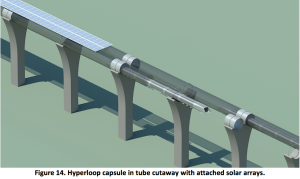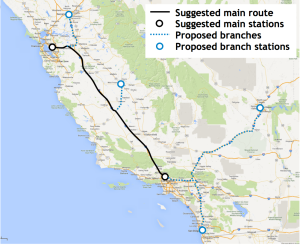Inventor, philanthropist, billionaire, and titan of industry Elon Musk unveiled a 57-page plan yesterday for a super-speed train that would take passengers between LA and San Francisco in just 30 minutes.
We previewed it, and we covered it.
But there’s a lot more to know about the Hyperloop — a high-speed train-in-a-tube that makes all other high-speed trains look like they’re stuck in first gear — including the current fastest train in the world in regular operation, the 268 mph Shanghai maglev train, which I’ve personally ridden.
You could all read those 57 pages — or scan these Cole’s Notes.
June 5th: The AI Audit in NYC
Join us next week in NYC to engage with top executive leaders, delving into strategies for auditing AI models to ensure fairness, optimal performance, and ethical compliance across diverse organizations. Secure your attendance for this exclusive invite-only event.
The basic Hyperloop concept in a nutshell:
- People-carrying capsules running through a long metal tube
- 28-person capacity
- 40 total capsules in activity at rush hour
- Almost a cross between the pneumatic tube delivery systems in old buildings and a Japanese bullet train
- Capsules float on cushions of air like hockey pucks
- Tube is elevated on 25,000 concrete pylons
The Hyperloop’s speed and initial routes:
- Up to 760 miles per hour, or Mach .91 at the tube’s air pressure
- Slowing to 300 mph for turns
- Compares to most airplanes’ speed of 550 mph
- At Hyperloop speeds, travel time from L.A. to San Francisco is 30 minutes
- Additional cities to be added later: San Diego, Sacramento, and Fresno
- Passenger capsules: $1.3 million each
- Car and cargo capsules: $1.5 million each
- Stations: $125 million each
- Tube, pillars, and stations: $4 billion, or $5.31 billion for a larger tube with higher capacity
- Total cost: $6.1 billion
- Comparison: the proposed California High Speed Rail project is estimated at $68.4 billion
Air, pressure, and pumping:
- Atmospheric pressure inside the tube: 17 percent of the pressure of Mars, which is already only 1 percent of Earth at sea level
- Equivalent to the air pressure on earth at 150,000 feet, four times higher than most airplanes fly
- There’s still too much pressure against the capsules, so each capsule pumps air from the front to the back via a compressor — and uses some of it to float on like a hockey puck
Power:
- All power is provided by solar panels on the top of the 381-mile-long tube
- Energy cost per passenger: less than 100 megajoules (about 3/4 of a gallon of gas)
- Energy cost per car in cargo capsules: about 220 megajoules
- Per-passenger comparisons: car (800 MJ), motorcycle (900MJ), airplane (1100 MJ)
 Ticket prices and round-trip travel times:
Ticket prices and round-trip travel times:
- Hyperloop: $40 round-trip
1 hour 10 minutes total travel time - Airplane: $158 round-trip
2 hours 30 minutes total travel time - Car: $115 round-trip (gas only)
11 hours total travel time - Proposed California High Speed Rail: $210 round-trip
5 hours total travel time
- Capsules always connected via radio with station operators
- Redundant power supplies on-board
- Backup mechanical braking mechanism in case electrical motors fail
- Oxygen masks for passengers deploy in case of depressurization
- Tube can be rapidly re-pressurized if needed
- Tube built with flexibility to withstand earthquakes
Motors
- Motors are in the tubes, not the capsules
- Hyperloop uses linear induction electric motors, similar to those in the Tesla
- The linear induction motor works via electromagnetism
- Motors are only required for about one percent of the tube: initial speed-up and quick top-ups every 70 miles
- Most of the time, capsules simply coast











